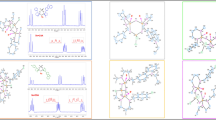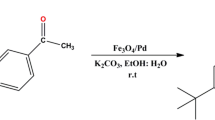Abstract
Since calixarenes are more easily synthesized and functionalized than other supramolecules, they are compounds of interest in organic chemistry. In this study, the dihydrazide (3a and 3b) and diamino propyl (6a and 6b) derivatives of p-tert-butylcalix[4]arene and calix[4]arene were synthesized. Then the L-proline methyl ester substituted chlorocyclopropenium was reacted with the calix[4]arene derivatives (3a, 3b, 6a, and 6b) at room temperature in CH2Cl2 to obtain calix[4]arene superbase derivatives (4a, 4b, 7a, and 7b) in 75%, 60%, 70%, and 55% yield, respectively. The synthesized compounds’ structure was elucidated using spectroscopic techniques (FTIR, 1H NMR, and 13C NMR). The cytotoxic properties of the calix[4]arene superbase derivatives were investigated against different human cancer cell, including A549, DLD-1, HEPG2, and PC-3 and human healthy epithelium cell line PNT1A. The cytotoxicity results showed that calix[4]arene superbase derivatives inhibited the proliferation of DLD-1, A549, HEPG2, and PC-3 cells in a dose-dependent manner. Compound 7a had the highest toxic effect on colorectal carcinoma (IC50: 4.7 µM), and the IC50 values were 18.5 µM and 74.4 µM against human prostate and lung cancer cells, respectively. Furthermore, compound 4b was found more effective on hepatocellular carcinoma cells (IC50: 210.2 µM). As a result, the synthesized calix[4]arene superbase derivatives can be developed to treat different human cancer cell. They can be considered as a preliminary result for molecular-level research.





Similar content being viewed by others
References
Kovacevic B, Maksic ZB. Basicity of some organic superbases in acetonitrile. Org Lett. 2001;3:1523–6.
Komatsu K, Kitagawa T. Cyclopropenylium cations, cyclopropenones, and heteroanalogues recent advances. Chem Rev. 2003;103:1371–428.
Bruns H, Patil M, Carreras J, Vázquez A, Thiel W, Goddard R. et al. Synthesis and coordination properties of nitrogen (I)-based Ligands. Angew Chem Int Ed. 2010;49:3680–3.
Bandar JS, Lambert TH. Enantioselective bronsted base catalysis with chiral cyclopropenimines. J Am Chem Soc. 2012;134:5552–5.
Maksić ZB, Kovacevic B. Spatial and electronic structure of highly basic organic molecules: cyclopropeneimines and some related systems. J Phys Chem A. 1999;103:6678–84.
Bandar JS, Lambert TH. Cyclopropenimine-catalyzed enantioselective mannich reactions of tert-butyl glycinates with n-boc-imines. J Am Chem Soc. 2013;135:11799–802.
Bandar JS, Barthelme A, Mazori AY, Lambert TH. Structure-activity relationship studies of cyclopropenimines as enantioselective Brønsted base catalysts. Chem Sci. 2015;6:1537–47.
Neri P, Sessler JL, Wang MX. Calixarenes and beyond. 2016: Springer.
Mutihac L, Lee JH, Kim JS, Vicens J. Recognition of amino acids by functionalized calixarenes. Chem Soc Rev. 2011;40:2777–96.
Zadmard R, Schrader T. DNA recognition with large calixarene dimers. Angew Chem Int Ed. 2006;45:2703–6.
Ozyilmaz E, Bayrakci M, Yilmaz M. Improvement of catalytic activity of Candida rugosa lipase in the presence of calix [4] arene bearing iminodicarboxylic/phosphonic acid complexes modified iron oxide nanoparticles. Bioorg Chem. 2016;65:1–8.
Yousaf A, Hamid SA, Bunnori NM, Ishola AA. Applications of calixarenes in cancer chemotherapy: facts and perspectives. Drug Des Dev Ther. 2015;9:2831
Karakurt S, Kellici TF, Mavromoustakos T, Tzakos AG, Yilmaz M. Calixarenes in lipase biocatalysis and cancer therapy. Curr Org Chem. 2016;20:1043–57.
Oguz M, Gul A, Karakurt S, Yilmaz M. Synthesis of new picolylamine bearing calix [8] arene Derivatives as Antiproliferative Agents for Colorectal Carcinoma. Chemistry Select. 2020;5:12250–4.
Oguz M, Kalay E, Akocak S, Nocentini A, Lolak N, Boga M, et al. Synthesis of calix [4] azacrown substituted sulphonamides with antioxidant, acetylcholinesterase, butyrylcholinesterase, tyrosinase and carbonic anhydrase inhibitory action. J Enzym inhibition medicinal Chem. 2020;35:1215–23.
Oguz M, Bhatti AA, Dogan B, Karakurt S, Durdagi S, Yilmaz M. Formation of the inclusion complex of water soluble fluorescent calix [4] arene and naringenin: solubility, cytotoxic effect and molecular modeling studies. J Biomolecular Struct Dyn. 2020;38:3801–13.
An L, Wang C, Zheng YG, Liu JD, Huang TH. Design, synthesis and evaluation of calix [4] arene-based carbonyl amide derivatives with antitumor activities. Eur J Medicinal Chem. 2021;210:112984.
An L, Han LL, Zheng YG, Peng XN, Xue YS, Gu XK, et al. Synthesis, X-ray crystal structure and antitumor activity of calix [n] arene polyhydroxyamine derivatives. Eur J medicinal Chem. 2016;123:21–30.
Williams GT, Haynes CJE, Fares M, Caltagirone C, Hiscock JR, Gale PA. Advances in applied supramolecular technologies. Chem Soc Rev. 2021.
Rocha-Brito KJP, Fonseca EMB, Oliveira BGF, Fátima Â, Ferreira-Halder CV. Calix [6] arene diminishes receptor tyrosine kinase lifespan in pancreatic cancer cells and inhibits their migration and invasion efficiency. Bioorg Chem. 2020;100:103881.
Yilmaz B, Bayraç AT, Bayrakci M. Evaluation of anticancer activities of novel facile synthesized calix [n] arene sulfonamide analogs. Appl Biochem Biotechnol. 2020;190:1484–97.
Pur FN. Calix [4] API-s: fully functionalized calix [4] arene-based facial active pharmaceutical ingredients. Mol Diversity. 2020:1–12.
Goh CY, Fu DY, Duncan CL, Tinker A, Li F, Mocerino M, Ogden MI, Wu Y. The inhibitory properties of acidic functionalised calix [4] arenes on human papillomavirus pentamer formation. Supramolecular Chem. 2020;32:345–53.
Läppchen T, Dings RPM, Rossin R, Simon JF, Visser TJ, Bakker M, et al. Novel analogs of antitumor agent calixarene 0118: Synthesis, cytotoxicity, click labeling with 2-[18F] fluoroethylazide, and in vivo evaluation. Eur J Medicinal Chem. 2015;89:279–95.
Dings RPM, Levine JI, Brown SG, Astorgues-Xerri L, MacDonald JR, Hoye TR, et al. Polycationic calixarene PTX013, a potent cytotoxic agent against tumors and drug resistant cancer. Investigational N. Drugs. 2013;31:1142–50.
Hoskins C, Curtis AD. Simple calix [n] arenes and calix [4] resorcinarenes as drug solubilizing agents. J Nanomed Res. 2015;2:3.
Wang GS, Zhang HY, Ding F, Liu Y. Preparation and characterization of inclusion complexes of topotecan with sulfonatocalixarene. J Incl Phenom Macrocycl Chem. 2011;69:85–9.
Yilmaz M, Karanastasis AA, Chatziathanasiadou MV, Oguz M, Kougioumtzi A, Clemente N, et al. Inclusion of quercetin in gold nanoparticles decorated with supramolecular hosts amplifies its tumor targeting properties. ACS Appl Bio Mater. 2019;2:2715–25.
Noruzi EB, Molaparast M, Zarei M, Shaabani B, Kariminezhad Z, Ebadi B, et al. Para-sulfonatocalix [n] arene-based biomaterials: Recent progress in pharmaceutical and biological applications. Eur J Medicinal Chem. 2020;190:112121.
Coleman WA, Baggetto LG, Lazar AN, Michaud MH, Magnard S. Calixarene derivatives as anticancer agent. 2010, Google Patents.
Fu D, Lu T, Liu Y, Wang Y, Li F, Wu Y, et al. Enantioselective Inhibition of human papillomavirus L1 pentamer formation by chiral-proline modified Calix [4] arenes: targeting the protein interface. Chem Sel. 2016;1:6243–43.
Oguz M, Gul A, Karakurt S, Yilmaz M. Synthesis and evaluation of the antitumor activity of Calix [4] arene L-proline derivatives. Bioorg Chem. 2020;94:103207.
Krzyszczyk P, Acevedo A, Davidoff EJ, Timmins LM, Marrero-Berrios I, Patel M, et al. The growing role of precision and personalized medicine for cancer treatment. Technol (Singap World Sci). 2018;6:79–100.
Pelizzaro-Rocha KJ, Bispo de Jesus M, Ruela-de-Sousa RR, Nakamura CV, Reis FS, De Fátima A, et al. Calix[6]arene bypasses human pancreatic cancer aggressiveness: Downregulation of receptor tyrosine kinases and induction of cell death by reticulum stress and autophagy. Biochim Biophys Acta. 2013;1833:2856–65.
Dings RPM, Miller MC, Nesmelova I, Astorgues-Xerri L, Kumar N, Serova M, et al. Antitumor agent calixarene 0118 targets human galectin-1 as an allosteric inhibitor of carbohydrate binding. J Medicinal Chem. 2012;55:5121–9.
Gutsche CD, Iqbal M. p‐tert‐Butylcalix [4] arene. Org Syntheses. 2003;68:234–4.
Collins EM, McKervey MA, Madigan E, Moran MB, Owens M, Ferguson G, et al. Chemically modified calix [4] arenes. Regioselective synthesis of 1, 3-(distal) derivatives and related compounds. X-Ray crystal structure of a diphenol-dinitrile. J Chem Soc Perkin Trans. 1991;1:3137–42.
Arnaud-Neu F, Collins EM, Deasy M, Ferguson G, J. Harris S, Kaitner B, et al. Synthesis, X-ray crystal structures, and cation-binding properties of alkyl calixaryl esters and ketones, a new family of macrocyclic molecular receptors. J Am Chem Soc. 1989;111:8681–91.
Karakurt S, Abusoglu G, Arituluk ZC. Comparison of anticarcinogenic properties of Viburnum opulus and its active compound p-coumaric acid on human colorectal carcinoma. Turk J Biol. 2020;44:252–63.
Acknowledgements
The authors are grateful to the Research Foundation of the Scientific and Technological Research Council of Turkey (TUBITAK-Grant Number 116Z173) and Selcuk University (BAP) to support this study.
Author information
Authors and Affiliations
Corresponding author
Ethics declarations
Conflict of interest
The authors declare no competing interests.
Additional information
Publisher’s note Springer Nature remains neutral with regard to jurisdictional claims in published maps and institutional affiliations.
Supplementary information
Rights and permissions
About this article
Cite this article
Oguz, M., Yildirim, A., Durmus, I.M. et al. Synthesis of new calix[4]arene derivatives and evaluation of their cytotoxic activity. Med Chem Res 31, 52–59 (2022). https://doi.org/10.1007/s00044-021-02813-7
Received:
Accepted:
Published:
Issue Date:
DOI: https://doi.org/10.1007/s00044-021-02813-7




